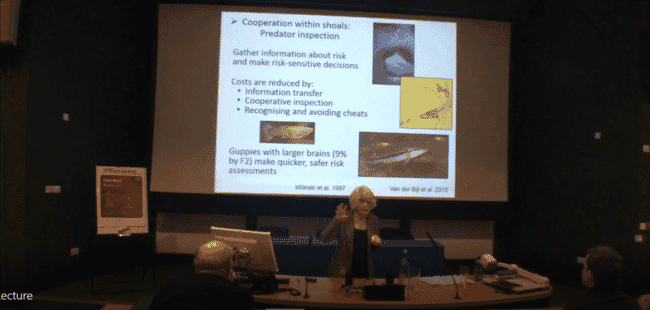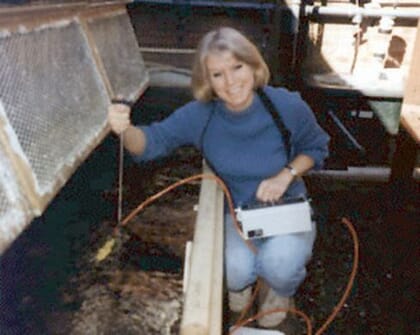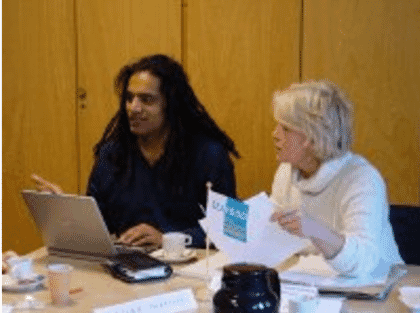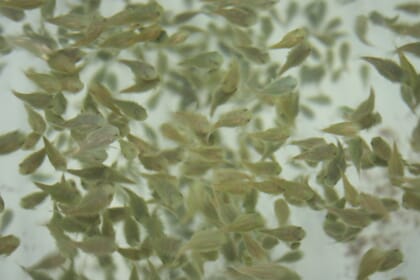What made you decide to study fish behaviour?
Biology was one of my favourite subjects at school, not least because we had a brilliant teacher, and I chose to study zoology at Oxford, where I developed an interest in animal behaviour, inspired in part by the lectures of Niko Tinbergen – a Nobel Prize winner – and Richard Dawkins. In my final year (1970) I decided that I wanted to carry on with a doctorate on animal behaviour, and one of the staff in the Animal Behaviour Research Group, Mike Cullen, suggested a very interesting research topic, on the nature of animal aggression. He had the neat idea following the behaviour of individual animals (given dye marks so that they could be identified) and using individual differences as a research tool.

Mike suggested that a suitable species to answer these questions would be the three-spined stickleback and he turned out to be absolutely right. Stickleback are amazing fish to work with: they’re small, robust and very tractable as lab animals. You can put them in a tank, go make a cup of coffee and find them building a nest by the time you return. They also have what nowadays would probably be called unique “personalities”, with some individuals being consistently more prone to aggression or risk-taking, for example, than others.
A year after finishing my doctorate, in 1974, I accepted the offer of a lectureship in at the University of Glasgow. From the very start I really liked the city, the university and the department and I’ve never been tempted to move away.

Why did you decide to switch from studying sticklebacks to salmon?
I did not switch so much as add another study species to my research. Like most projects, my doctoral research raised as many questions as it answered and I initially continued to work with sticklebacks, pursuing questions about, for example, how individual differences in risk-taking develop and how they influence important traits for fitness, such as food acquisition and growth.
However, I wanted to follow up these questions by looking at how behavioural style, or personality, can influence the timing of key life-history events, such as migration and maturation. Sticklebacks were not particularly suitable for such research, as the timing of their life-history events is not very variable. In contrast, Atlantic salmon are famously variable in the timing of their seaward migration (which can take place after anything from one to four years) and the age at which they mature. This made them a natural choice as a species with which to study links between behaviour and life-history patterns.

So in the mid-1980s, along with my colleague Neil Metcalfe, I contacted John Thorpe at Freshwater Fisheries Laboratory in Pitlochry and initiated the first in a series of projects on behavioural determinants of the timing of life-history events in Atlantic salmon. As well as being the right species to work on in terms of fundamental questions, I have always thought that being paid to do research into a subject of absorbing interest is a serious privilege and, all other things being equal, it seems right to address one’s research questions with economically important species, because the results might be of practical value.
Initially we worked with wild fish, but it was a natural progression to then look at similar questions in farmed salmon. The industry was growing in economic importance and it is also much easier to obtain some kinds of data from farmed fish than from the wild. One of our first projects on farmed fish was funded by a grant from the Scottish Salmon Growers’ Association [the forerunner of the SSPO]. Working with Sunil Kadri, a recent graduate from Stirling’s Institute of Aquaculture, we put an underwater camera into a lightly stocked sea cage and recorded behavioural interactions between the fish, especially during feeding. Among other things, the study showed the extent of the aggression between the fish. Good fish farmers were already aware of this, but it was satisfying to be able to quantify it and to put it into a biological context. This initial short project also led to many further studies, mostly relating to behavioural influences on production and welfare in farmed fish.
How has your relationship with the aquaculture sector evolved?
I officially retired seven years ago, so I’m now as likely to be looking after my grandchildren as doing aquaculture-related work. Even before I retired, I would say that I really worked with aquaculture rather than within it. My typical working day would mainly have been taken up with university business, with occasional forays out into the world of fish farming.
However, aquaculture has been a constant theme for a number of reasons, not least because I have supervised many aquaculture-related PhD students, usually at least two in any particular year. These students studied in research facilities and on working farms, in many countries including the UK, Italy, Spain, Greece and Norway; on species such as salmon, rainbow trout, seabass, sea bream, carp; and on subjects ranging from fish behaviour to nutrition.
My role was to link up the students with colleagues in aquaculture. It was important to ensure that the students were not only scientifically capable, but also able to live and work in often isolated locations. I also helped to design, fund and plan the projects, visit the study sites to help get experiments set up and to check on progress. When data collection was complete, the students usually returned to Glasgow, where I was closely involved with data analysis and write-ups.
Quite a few of my PhDs are still involved in aquaculture. Sunil Kadri is well known for his impressive work as an interface between research and the industry; Chris Noble, who is now at Nofima in Tromso, has recently published the FISHWELL salmon-welfare handbook; and Jen Andrew, whose research into feeding in farmed sea bream explored a new design for bream pellets, is now – fortunately for the children of a school near Inverness – a biology teacher.

I’ve also been involved in numerous collaborative research projects, mainly though not exclusively funded by the EU, so I am currently in mourning. These projects have included, for example, working with Jimmy Turnbull and colleagues from the Institute of Aquaculture on the effects of stocking density on the welfare of farmed salmon. We demonstrated that both very high and very low stocking densities were detrimental to welfare, the latter because the extra space leads to more fighting and a higher number of injuries.
I have also taken part in and spoken at many aquaculture workshops and conferences, especially on the subject of the welfare of farmed fish.
How can the growing body of knowledge of fish behaviour be practically applied to improve the welfare of farmed fish?
There are many ways. Scientific understanding of fish behaviour, combined with the knowledge of good fish farmers, who spend so much time observing their fish, have helped the sector evolve.
It has been extensively documented that many aspects of aquaculture cause physiological stress responses in farmed fish, and much effort has gone into the development of low-stress husbandry practices. For example, size grading fish often requires a lot of handling, as fish are netted into the air and passed through grids. Passive grading, in which smaller fish can pass through a grading mesh within a pen, is becoming more popular and can be made faster and more effective by training fish with food to swim towards lights, which ae then used to coax the fish through without crowding them. This is a way of exploiting both innate and learned responses.
Behavioural studies have also helped to make feed more attractive – the shape, size and smell of pellets, as well as their nutritional content, can be adjusted to encourage fish to eat manufactured feed. Equally, understanding natural behavioural rhythms helps farmers to ensure that food is delivered at times when fish are most likely to eat it. Various kinds of feeders have been developed that allow farmers to feed their fish according to appetite, which among other beneficial effects help to produce good, uniform growth and reduce fighting over food.
Why are you particularly interested in the relationship between cleaner fish and their clients (eg wrasse and salmon)?
From a fundamental perspective, this relationship is fascinating to behavioural biologists, because this symbiosis between the obligate blue streak cleaner wrasse and its clients involves many complex interactions – investigated in a series of neat and powerful experiments by Redouan Bshary and his colleagues. For example, although cleaner fish will remove ectoparasites from their clients, they prefer to bite off and swallow a mouthful of mucous and scales (a form of cheating). A client that has been bitten in this way may well avoid the offending cleaner in the future and cleaner fish have a well-developed capacity for self-restraint, readily learning to feed against preference on any given occasion to receive a later reward. If a cleaner fails to show such self-restraint and does bite a familiar client, it often performs the most amazing behaviour, rolling its body down the spine of the offended client, giving it, as it were, a complimentary massage and restoring good relations.

From an applied perspective, the relationship is of interest because it potentially offers a much-needed additional solution to the sea lice problem. For this solution to work effectively it is important to know that cleaner fish will remove ectoparasites and that sufficient structure is needed in their environment to allow them to maintain a feeding station and potential clients to find them. It is not clear that a knowledge of the more cognitively demanding aspects of the symbiosis is also needed, because most of the cleaner species used in salmon farming, for example, are not obligate cleaners and will not have been under strong selection for these complex behavioural traits.
What are the most memorable experiences you’ve had during your five decades of working with fish?
One of the most memorable, from a negative perspective, was nearly drowning while collecting stickleback from the River Kelvin. I was in a hurry and broke all the rules by going into the field on my own. It was winter and, wearing chest waders, I was fishing along the edge of the river, just up to my knees in the water. It was going fine until, from one pace to the next, I stepped into a vertical chimney of a disused mill and suddenly found myself with just my head and shoulders above the freezing water. Thankfully I’ve got quite broad shoulders, otherwise I’d have disappeared completely into the chimney. I I managed to grab a branch, pulled myself out of the river, collected my bucket and arrived back at the university, soaked and freezing to the bone to deliver the stickleback I’d managed to catch before this accident. Thankfully also, one of the technicians in my department had the sense to pack me off home to get warm and dry.
A more positive example is neither particularly dramatic nor novel, but it knocks me sideways every time I watch a male stickleback setting up his territory, building his nest, fanning his eggs (to adjust the oxygen levels), mouthing them to reduce fungi, chasing after his fry when they first start to stray, catching them in his mouth and spitting them back to the safety of this nest (and in the process, teaching them how to escape from a larger fish). In 2014, this remarkable little fish featured in BBC2’s Springwatch programme, and the audience was just as captivated as I have always been.
Are there any individuals or organisations in the industry or academia who you’ve found particularly inspirational?
I’ve been lucky to work with many remarkable people. My mentors have included, at Oxford, my tutor, Peggy Varley – who wrote the definitive book on brown trout, was brilliant as lecturer and scientist, without making an issue of it, and combined a successful career with raising a family – and also Mike Cullen, my PhD supervisor, for his perfect hands off, but supportive, supervision. In Glasgow, I owe a lot to David Newth, my first head of department for, among many other things, hiring female academics long before this was the norm and for saying to me, after I’d made a stupid error that had cost the department, that everyone is entitled to one mistake. I owe a great debt of gratitude to John Thorpe, the world’s expert on salmon, for his patient advice and kind encouragement.
In addition to these mentors and role models, I have been inspired by many colleagues and students who share my interests but brought a different perspective to our collaborations. These include Neil Metcalfe, for his expertise in ecology; Sunil Kadri for being such an effective interface with the aquaculture industry; Jimmy Turnbull for his veterinary knowledge; Victoria Braithwaite for her insights into animal psychology and fieldwork skills; Simon Mackenzie, combining expertise in molecular biology with an interest in evolutionary questions; and Martina Quaggiotto, a marine ecologist with whom I collaborated to develop several presentations summarising current evidence for well-developed cognitive abilities in fish and for their importance for effective fisheries.

What advice would you give to women looking to start a career in fish research?
I would give almost exactly the same as I’d give to men in the same situation: find good questions, choose a good study species and the right people to work with, then go for it.
I would say to women looking to start a career in any branch of science that, while they do not need to be pushy and aggressive, they do need to recognise their own strengths and the quality of their research and to be prepared, in the right context, to speak about them with confidence.
What would be your dream role in aquaculture?
It might sound Pollyanna-ish, but I really cannot see a role that suits me better than the one I’ve had, collaborating closely with both aquaculture researchers and people directly involved in the fish farming. I would be happy to do it all again, though of course, second time round, I’m sure I would do some things better.
What element of fish behaviour would you most like to understand?
I am fascinated by predator inspection, having often watched in amazement as a stickleback swims right into the strike zone of a pike. Its spines are up, its skin is dark and it’s clearly showing signs of stress, but it still keeps moving forward. We know that moving close to inspect a predator allows the stickleback to collect information about just how much of a risk this particular predator poses. However, there is still a lot about predator inspection that we do not understand, particularly in terms of what motivates small fish (or any prey animals) to take such risks. It highlights the importance of uncertainty reduction as a strong motivation and this potentially has really interesting implications for welfare, if captive fish can perceive potential risks (the presence of a real predator outside the pen, for example, or simply the sound of a passing boat) but are unable to assess them.
I certainly will not be setting up my lab again, but I am hoping to work on this with other researchers who are interested in this topic.








